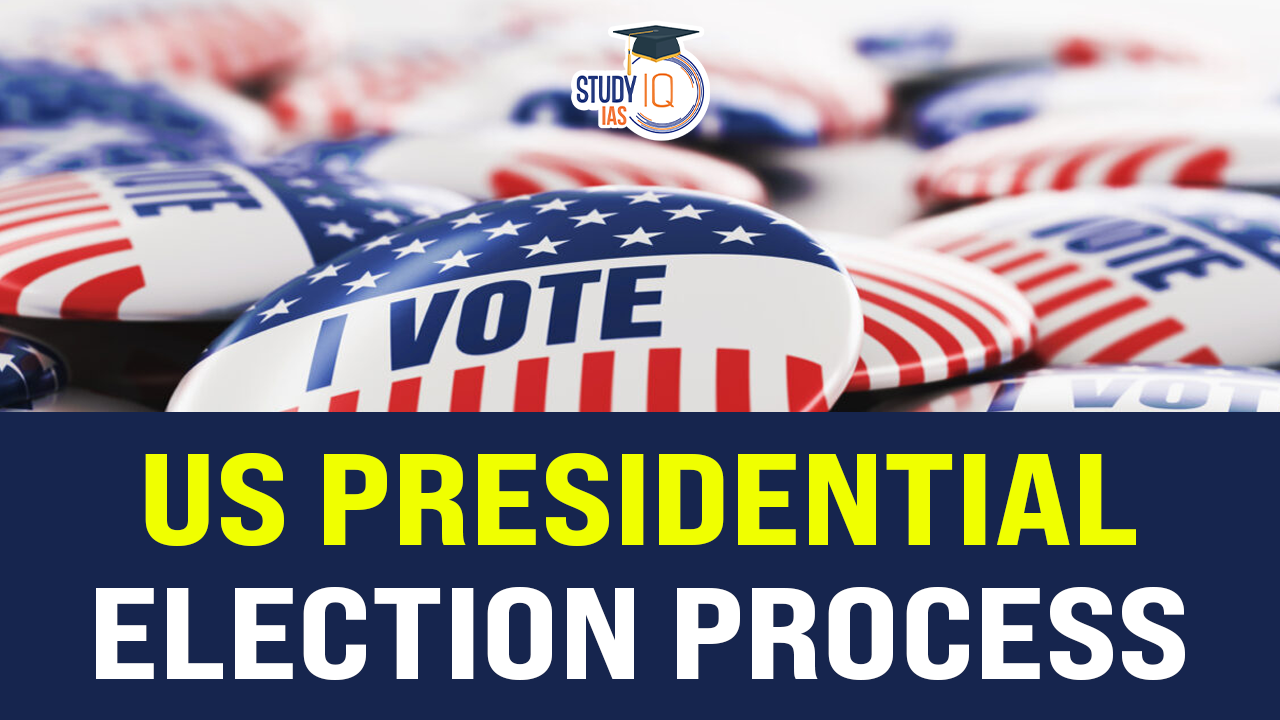Table of Contents
Context: Campaign rallies for the election of President began in the United States.
Process of Elections
- Eligibility Requirements: To run for President,
- A candidate must be at least 35 years old
- Natural-born citizen of the United States
- Have lived in the U.S. for at least 14 years.
- General Election: The general election takes place on the first Tuesday after the first Monday in November.
- Voters cast their ballots for presidential candidates.
- In the general election, voters are actually voting for electors in the Electoral College, not directly for a president and vice president.
- Electoral College: The Electoral College is the body that officially elects the President and Vice President.
- It consists of 538 electors, with each state allocated electors based on its congressional representation.
- Winner-Takes-All System: In most states (except Maine and Nebraska) Candidate who wins the majority of votes in a state wins all of that state’s electoral votes.
- Proportional System: Maine and Nebraska allocate their electoral votes based on the vote proportion each candidate gets.
- Electors Meeting: In mid-December, electors meet in their respective states to vote for President and Vice President.
- Congressional Count: In January, Congress counts these votes in a joint session, and the candidates with a majority of at least 270 electoral votes are declared winners.
- Inauguration: The President-elect and Vice President-elect take the oath of office and are inaugurated on January 20th following the election.
TRUMP LOST Debate and Kamala Harris Wins
In a stunning turn of events, Kamala Harris emerged victorious in the highly anticipated 2024 debate against former President Donald Trump. The debate, which was held in Philadelphia, saw Harris dominate Trump in both style and substance, surprising many political analysts.
Key Moments:
- Harris’s Strong Performance: Kamala Harris adopted a calm, assertive approach, skillfully challenging Trump’s statements and maintaining control of the discussion. Her sharp responses resonated well with viewers, giving her the upper hand.
- Trump’s Struggles: Trump appeared unsettled at various points, struggling to present coherent arguments and often relying on emotional rhetoric. His focus on controversial topics backfired, as Harris effectively exposed the weaknesses in his arguments.
- Poll Reactions: Polls conducted after the debate, including by major outlets like CNN and YouGov, showed Harris winning significantly. Even traditionally conservative commentators acknowledged her debate victory.
This result could profoundly impact the 2024 presidential race, with Harris gaining momentum while Trump’s performance raised doubts about his candidacy.
Biden is Out of the US Presidential Race
Joe Biden, 81, has dropped out of the 2024 US presidential election, endorsing Vice President Kamala Harris as the Democratic nominee. Biden cited the “best interest of my party and the country” following a poor debate performance against Trump, which raised concerns about his age and mental fitness. Harris aims to become the first female president, receiving endorsements and $27.5 million in donations.
Democrats will confirm their candidate at the August 19 convention. Biden, recovering from Covid, will address the nation later this week. Trump’s campaign faces a younger opponent, altering the election landscape.
Who is US Vice-Presidential Candidate JD Vance?
JD Vance is an American politician, author, and venture capitalist, currently serving as a Republican senator from Ohio. He gained national recognition with his memoir, “Hillbilly Elegy: A Memoir of a Family and Culture in Crisis,” published in 2016. The book, which explores Vance’s upbringing in a working-class family in Middletown, Ohio, and the broader issues facing the white working class in America, became a bestseller and was adapted into a film by Netflix in 2020.
- Name: JD Vance
- Current Position: Republican Senator from Ohio
- Notable Work: Author of “Hillbilly Elegy”
- Early Life: Born in Middletown, Ohio, faced poverty and substance abuse in family
- Education: Ohio State University (Political Science and Philosophy), Yale Law School
- Career: Co-founded Narya Capital, focused on Midwestern startups
- Political Shift: Initially criticized Trump, later became a supporter
- Senate Campaign: Won Ohio Senate seat in 2022 with Trump’s endorsement
- Views: Conservative, focuses on immigration, trade, and American workers
- VP Candidacy: Chosen by Trump as 2024 running mate for his strategic appeal
Election of US President
- Announcement of Candidacy: Candidates typically announce their intention to run in the year preceding the election. This stage includes setting up campaign teams, conducting rallies, and fundraising.
- Eligibility Requirements: To run for President, a candidate must be at least 35 years old, a natural-born citizen of the United States, and have lived in the U.S. for at least 14 years.

Procedure of Election of US President
1. Primaries and Caucuses
These are held in states between January and June of the election year.
- They are the primary methods by which states choose delegates to represent them at national party conventions.
- Primaries: State-run elections where voters cast secret ballots for their preferred presidential candidates.
- Caucuses: Party-run meetings where members discuss and vote openly to choose their preferred candidate and delegates.
- Timing: Early 2024 to mid-2024
- Purpose: To select delegates who will support particular candidates at the national party conventions.
2. National Conventions
Each major political party holds a national convention typically in the summer before the election.
- Here, delegates from primaries and caucuses endorse a candidate.
- The candidate with a majority of delegates receives the party’s nomination.
- If no candidate has a majority, additional rounds of voting occur until a nominee is selected.
- Timing: Summer 2024
- Purpose: To officially nominate the party’s candidate for President and Vice President.
3. General Election Campaigning
Following the conventions, the nominated presidential candidates campaign across the country, participating in debates and rallies to garner support from the general electorate.
- Timing: Post-convention to early November 2024
- Purpose: To campaign for the general election.
- Process:
- Candidates from the major parties (Democratic and Republican) and any third-party or independent candidates campaign across the country.
- Debates, rallies, advertisements, and other campaign activities are conducted to persuade voters.
4. General Election
The general election takes place on the first Tuesday after the first Monday in November.
- Voters cast their ballots for presidential candidates.
- In the general election, voters are actually voting for electors in the Electoral College, not directly for a president and vice president.
- Timing: November 5, 2024 (Election Day)
- Purpose: To select the President and Vice President.
5. Electoral College
The Electoral College is the body that officially elects the President and Vice President.
- It consists of 538 electors, with each state allocated electors based on its congressional representation.
- Winner-Takes-All System: In all but two states (Maine and Nebraska), the candidate who wins the majority of votes in a state wins all of that state’s electoral votes.
- Proportional System: Maine and Nebraska allocate their electoral votes based on the proportion of the vote each candidate gets.
- Timing: December 2024
- Purpose: To officially elect the President and Vice President.
6. Electors Meeting
In mid-December, electors meet in their respective states to cast their votes for President and Vice President.
7. Congressional Count
In January, Congress counts these votes in a joint session, and the candidates with a majority of at least 270 electoral votes are declared winners.
- Timing: Early January 2025
- Purpose: To formally count the electoral votes.
8. Inauguration
The President-elect and Vice President-elect take the oath of office and are inaugurated on January 20th following the election.
- Timing: January 20, 2025
- Purpose: To officially install the new President and Vice President.
Also, Check US Election Result 2024


 Industrial Parks in India: Driving Manuf...
Industrial Parks in India: Driving Manuf...
 National Maritime Heritage Complex (NMHC...
National Maritime Heritage Complex (NMHC...
 Reforming Fertiliser Subsidy in India: N...
Reforming Fertiliser Subsidy in India: N...

























